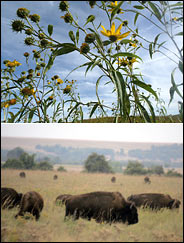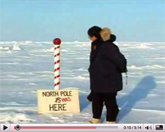Dale R. McIntyre of Bartlesville, Okla., a frequent contributor, sent in the following description of a bison encounter as a comment on my piece exploring a plan to rebuild wild bison populations in the West. I thought it was worth highlighting as an example of a powerful personal interaction with the planet’s other inhabitants and would love to use this “Your Dot” post as an invitation to others to describe experiences they’ve had that have changed how they think or behave in relation to the wider environment.
 Librado Romero/ The New York Times TOP Neal Smith National Wildlife Refuge near Prairie City, Iowa. BOTTOM The Tallgrass Prairie Preserve is home to 2,460 bison, below, a herd that has grown from the 300 reintroduced there in 1993.
Librado Romero/ The New York Times TOP Neal Smith National Wildlife Refuge near Prairie City, Iowa. BOTTOM The Tallgrass Prairie Preserve is home to 2,460 bison, below, a herd that has grown from the 300 reintroduced there in 1993.There is a magnificent herd of more than 2,500 bison which populates the 39,000-acre Tallgrass Prairie Preserve near Pawhuska, Okla.
The Tallgrass Prairie Preserve is already doing exactly what you describe in this posting; returning the land to a state of nature with the dominant species, the bison, in its proper place.
Last September I drove my family through the winding gravel roads of the preserve. The rolling prairie was covered with thousands of acres of wildflowers, bluebonnets and Indian Paint Brushes, in colors vivid enough to delight Chagall. Hundreds of bison grazed the low hills.
Just beside the road we noticed an enormous old bull buffalo, standing as tall, at his hump, as I am. This grizzled old patriarch was snorting and rolling his shoulders and wallowing in the dust. We stopped to watch. About 40 yards west we saw another bull trotting up. The younger bull was smaller than the elder but full of vigor. He too rolled his shoulders and wallowed in the dust, then resumed his trot toward the old bull.
Suddenly both bulls gave deep loud bellows and charged toward each other at top speed. Right by our van, the two behemoths collided with an echoing “Wham!” that shook the earth.
Bellowing and snorting, the two bulls swung their massive heads, hooking at each other with their horns, then backed off three paces to butt heads again.
But this time the big old bull backed up a step.
The younger bull charged in, hooking the elder bull with those needle-sharp horns, left-right-left. The older bull backed up another step, then another.
That quick, it was over. The entire passage of arms must have only lasted about 20 seconds. The old bull backed up some more, swung aside, and trotted away half a dozen strides, leaving the field, and about three dozen cows, to his younger rival.
Unforgettable.
Recall that this primordial combat took place within 25 feet of the open passenger-side window of our family van. Incredible.
So to anyone who wants to see how a revival of the prairie, and a renaissance of the buffalo, can be done and is being done, I urge you to go to the Tallgrass Prairie Preserve. Go north from Tulsa on Highway 75, turn onto Highway 60 at Bartlesville, go west on Highway 60 to Pawhuska, and follow the signs north to the Preserve.
Kudos to the Nature Conservancy, which bought most of the land for the Preserve, and runs it with an enlightened hand. The Preserve practices a “Patch-burn” procedure whereby they mimic the natural action of lightning-induced grass fires, burning off about a third of the preserve every year in patches, in controlled burns. They claim this kills back the invasive species and allows the native grasses and flowers to flourish.
No need to worry about lack of wolves and cougars. Mankind is the apex predator on earth, and the Preserve culls about 300 buffalo per year to keep the numbers in the herd in balance with the available grazing. Thus we sometimes find buffalo meat for sale in local grocery stores. We always snap it up; I prefer buffalo meat to beef any day. One hasn’t lived unless one has tasted three-bean buffalo-meat chili made with home-grown, home-made tomato sauce, oregano, and red chili peppers.
Earlier posters on this thread have recommended replacing the Great Plains’s cattle herds with herds of bison. Some of my rancher friends have tried it, with mixed success. They loved the freedom from vet bills, and freedom from feed-lot fees. In good times buffalo meat fetches a useful premium per pound compared to beef. On the debit side of buffalo ranching, as mentioned by other Dot Earth posters, the fences need to be greatly reinforced and, as one of my rancher friends tells me, “You can herd a buffalo anywhere as long as he wants to go there.” If not, well, not.
The 59,000-acre Wichita Mountains Wildlife Refuge near Lawton, Okla., also maintains a fine herd of about 650 bison which dates back to Teddy Roosevelt’s days.
Both are excellent but anyone who wants to know what the bison-dominated Great Plains were like, before settlement, needs to go have a look at the Tallgrass Prairie Preserve in Osage County, Okla.
Have you had encounters with wildlife or, more loosely, that thing called “nature” that have helped shape your life?


 Loading tweets...
Loading tweets...


 Apture allows readers to dig deeper into a subject without ever leaving the blog post. When you click on any link marked by the icons
Apture allows readers to dig deeper into a subject without ever leaving the blog post. When you click on any link marked by the icons 





